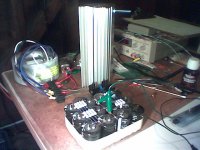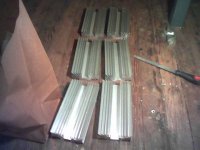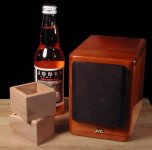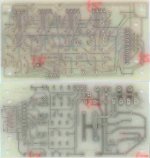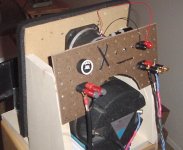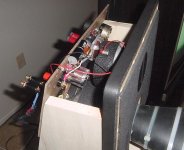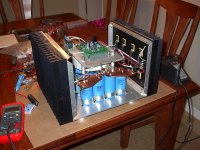I just finished tweaking the infinite baffle (in a seperating wall) speakers (Thorsten advice worked fine).
Right now, I'm getting to make some new mods on my Marantz CD94.
After that two CD-Pro transports to build, 2 non oversampling DACs, finish SOZ, modify and build chassis for two ML38 preamps, finish Aleph P preamp, modify the main open baffle speakers, build a phono preamp.
In the meantime build few more GainClones and TVC preamps😉
Right now, I'm getting to make some new mods on my Marantz CD94.
After that two CD-Pro transports to build, 2 non oversampling DACs, finish SOZ, modify and build chassis for two ML38 preamps, finish Aleph P preamp, modify the main open baffle speakers, build a phono preamp.
In the meantime build few more GainClones and TVC preamps😉
Magura said:Well...its very interesting, now that youve made it a secret 😀
Huh, web server went away. Sorry.
Attachments
Ok, not midway through anything so a just out of the chute photo will have to do.
For a couple years I'd had the notion of building some miniature monobloc integrated amps for my desktop to drive the speakers of my old JVC FS-2000 "executive" system (which has line out jacks).
I'd made a few initial stabs at it but thus far nothing had been quite as small as I'd have preferred.
Last night I was perusing one of the parts catalogs when I saw a cast aluminum heatsink intended for TO-3 devices. I'd seen it many times before but when I saw it last night, it gave me an idea as to how I could pull off a pair of miniature integrated amps.
I took the dimensions of the heatsink and the various other parts and sat down with AutoCAD for a while and figured that it should all work.
Today I ordered up some of the main parts (heatsinks, pots, and knobs) and this afternoon I did the woodworking for an initial mock-up of the amps.
If everything works as planned, each amp will have dimensions of 2-3/8 x 2-3/8 x 2-3/8 (about 60mm x 60mm x 60mm).
I've been wanting to work on my photography chops so I set up a little vignette which includes one of the FS-2000's speakers, a 12 oz. bottle of soda to give some sense of scale, and the unifinished cherry boxes I'll be using for the chassis mock-up.
The circuit will just be a simple LM-3875 affair with a +/- 12 volt supply (about 10 watts into 8 ohms). I'm not going to use input transformers for the first project but I did some doodling and I'm pretty sure I can do a trasnformer version within the same chassis dimenions.
Basically the heatsink will mount inside the cherry box with its fins sticking up 1/4" above the top and the volume control knob mounted concentrically within the heatsink and sticking up 1/4" further than the fins giving a total height of 2-3/8".
Anyway, here's my "just out of the chute" photo.
For a couple years I'd had the notion of building some miniature monobloc integrated amps for my desktop to drive the speakers of my old JVC FS-2000 "executive" system (which has line out jacks).
I'd made a few initial stabs at it but thus far nothing had been quite as small as I'd have preferred.
Last night I was perusing one of the parts catalogs when I saw a cast aluminum heatsink intended for TO-3 devices. I'd seen it many times before but when I saw it last night, it gave me an idea as to how I could pull off a pair of miniature integrated amps.
I took the dimensions of the heatsink and the various other parts and sat down with AutoCAD for a while and figured that it should all work.
Today I ordered up some of the main parts (heatsinks, pots, and knobs) and this afternoon I did the woodworking for an initial mock-up of the amps.
If everything works as planned, each amp will have dimensions of 2-3/8 x 2-3/8 x 2-3/8 (about 60mm x 60mm x 60mm).
I've been wanting to work on my photography chops so I set up a little vignette which includes one of the FS-2000's speakers, a 12 oz. bottle of soda to give some sense of scale, and the unifinished cherry boxes I'll be using for the chassis mock-up.
The circuit will just be a simple LM-3875 affair with a +/- 12 volt supply (about 10 watts into 8 ohms). I'm not going to use input transformers for the first project but I did some doodling and I'm pretty sure I can do a trasnformer version within the same chassis dimenions.
Basically the heatsink will mount inside the cherry box with its fins sticking up 1/4" above the top and the volume control knob mounted concentrically within the heatsink and sticking up 1/4" further than the fins giving a total height of 2-3/8".
Anyway, here's my "just out of the chute" photo.
Attachments
Steve Eddy said:For a couple years I'd had the notion of building some miniature monobloc integrated amps for my desktop to drive the speakers of my old JVC FS-2000 "executive" system (which has line out jacks).
Hi Steve,
You certain move faster on an idea than I do. I keep changing my mind. The only thing I haven't seriously considered is tubes.
And I was just thinking, I should take an AutoCAD course. I have access to it at work, but at home I'm using MS-Word Draw. Visio would be a step up.
Maybe I should have posted my JFET to copper plane in this thread. One thing I like about copper is it has a higher thermal conductivity than Al. However, the heatsink you have will likely be thick and have nice folds, etc. Maybe you know this already, but diamond is more than twice as thermally conductive as silver (which, of course, is better than copper). Diamond is unusual this way in that it is not electrically conductive (as most other thermally conductive materials are). http://www.nationmaster.com/encyclopedia/Thermal-conductivity
No major comments on your project. It seems like you got it worked out. One interesting point, you are making a miniature system. I did notice how small your mono blocks are to the mini speakers. This falls in line with your minature cloths pin (oh...darn, I HAD to bring up Woody again...).
One more thing, regarding the now closed, who cares anymore, thread on microdiodes. The link you posted on "Characterisation of Common Path Distortions" was certainly the closest thing I've see that describes a microdiode effect. I was looking at that today, I don't understand it, and don't know if there is anything practical there, but had wanted to mention that it's an interesting paper...
JF
johnferrier said:You certain move faster on an idea than I do. I keep changing my mind. The only thing I haven't seriously considered is tubes.
Hehehe. Two years is fast? 🙂
And I was just thinking, I should take an AutoCAD course. I have access to it at work, but at home I'm using MS-Word Draw. Visio would be a step up.
Unless you're going to do 3D modeling (which I don't), just get a third party book and play with it. I use it for 2D drawing and drafting and don't use more than half a dozen or so commands on a regular basis.
Maybe I should have posted my JFET to copper plane in this thread. One thing I like about copper is it has a higher thermal conductivity than Al. However, the heatsink you have will likely be thick and have nice folds, etc. Maybe you know this already, but diamond is more than twice as thermally conductive as silver (which, of course, is better than copper). Diamond is unusual this way in that it is not electrically conductive (as most other thermally conductive materials are). http://www.nationmaster.com/encyclopedia/Thermal-conductivity
Yeah. But can you imagine what a diamond heatsink of any size would cost? Yikes!
No major comments on your project. It seems like you got it worked out. One interesting point, you are making a miniature system. I did notice how small your mono blocks are to the mini speakers. This falls in line with your minature cloths pin (oh...darn, I HAD to bring up Woody again...).
Damn you, John Ferrier! Damn you to hell!
WOOOODDDYYYYYYYYYYYYYY!!!!!!!!




se
Damn that edit button. Hold still, John! 🙂
Glad you enjoyed it. Yeah, it's a bit to plow through alright. Been meaning to give it a re-read myself.
se
johnferrier said:One more thing, regarding the now closed, who cares anymore, thread on microdiodes. The link you posted on "Characterisation of Common Path Distortions" was certainly the closest thing I've see that describes a microdiode effect. I was looking at that today, I don't understand it, and don't know if there is anything practical there, but had wanted to mention that it's an interesting paper...
Glad you enjoyed it. Yeah, it's a bit to plow through alright. Been meaning to give it a re-read myself.
se
Steve Eddy said:Damn that edit button. Hold still, John! 🙂
I keep track of exactly how long I can edit or delete (after that it becomes history...).
Take care man!
JF
johnferrier said:I keep track of exactly how long I can edit or delete (after that it becomes history...).
Yeah, I noticed that. One of your posts in the InterFace thread up and disappeared on me while I was replying. 🙂
Take care man!
Ditto!
se
Originally posted by Magura
What are you all working at at the moment, it would give a little background info about the respective threads/- postings + funny to know how many are actually building something.
Magura
Making my first million - after that the next one should be easy.
My task this year is to quantify and then release a uniquely killer set of audio, video and power leads for the world's enjoyment.
If I can help it, live and home audio and video systems and recordings will never be the same again.
Eric.
What are you all working at at the moment, it would give a little background info about the respective threads/- postings + funny to know how many are actually building something.
Magura
Making my first million - after that the next one should be easy.
My task this year is to quantify and then release a uniquely killer set of audio, video and power leads for the world's enjoyment.
If I can help it, live and home audio and video systems and recordings will never be the same again.
Eric.
In order of time, I'm working on:
The garage
The new bathroom
A tube zen amp
An antique tube (like a 01a or something) preamp
Is anyone out there doing a tube preamp with no nfb and a pentode or mosfet load?
The garage
The new bathroom
A tube zen amp
An antique tube (like a 01a or something) preamp
Is anyone out there doing a tube preamp with no nfb and a pentode or mosfet load?
Its the Genie Excelerator. Works good, but the lead screw shutters a little. The low ceiling height on the garage ceiling kept me from doing any vibration isolation, so its a bit loud in the house.
I also built a workbench for the back of the garage but haven’t taken any pictures of it. I still have to add some edge banding to it and slop a couple of coats of poly over it.
If I ever finish this crap, this is where I’ll do some of my DIY audio stuff.
- Dave
I also built a workbench for the back of the garage but haven’t taken any pictures of it. I still have to add some edge banding to it and slop a couple of coats of poly over it.
If I ever finish this crap, this is where I’ll do some of my DIY audio stuff.
- Dave
2 projects
Working on My BOSOZ, just got the ever elusive switches, and just received the circuit boards from custom pcb, and turns out they actually work...mostly! As usual I went for too much, this thing is very complicated and my case is turning out to be very tight. Here are the boards, top one is for relay switching of the 4 balanced inputs, bottom one is for switching the selector LEDs to light up the one you selected, and on it is a regulated power supply for the auxilary circuits.
I am also working on an LM3886 Gainclone, you guys never mentioned that you have to connect up the "Mute" pin to unmute the chip. Jeeeeez, that would have saved me a day. Or I could have read the 1st section of the data sheet/ app note.
Working on My BOSOZ, just got the ever elusive switches, and just received the circuit boards from custom pcb, and turns out they actually work...mostly! As usual I went for too much, this thing is very complicated and my case is turning out to be very tight. Here are the boards, top one is for relay switching of the 4 balanced inputs, bottom one is for switching the selector LEDs to light up the one you selected, and on it is a regulated power supply for the auxilary circuits.
I am also working on an LM3886 Gainclone, you guys never mentioned that you have to connect up the "Mute" pin to unmute the chip. Jeeeeez, that would have saved me a day. Or I could have read the 1st section of the data sheet/ app note.
Attachments
Well, My holiday project is done minus some long term tweaking sessions.
http://www.diyaudio.com/forums/showthread.php?postid=291714#post291714
http://www.diyaudio.com/forums/showthread.php?postid=291714#post291714
Attachments
Magura said:What are you all working at at the moment, it would give a little background info about the respective threads/- postings + funny to know how many are actually building something.
Magura
Have an amp of my own design waiting for a cabinet. Did the 3D modeling, just need to build the thing!
Need an amp for my 2Kw SMPS... ...in my car. Power supply is done, need the amp now! 🙁
True sine wave PWM inverter to power my pc when the lights go out! (Actually, a full double conversion UPS). Waiting on holiday mail for the capacitors for the LP filters...
Trying to think of what to do with the pair of 45lb (20 kg) heatsinks I picked up the other day (20x9x6 inches),
(Pair of big monoblock, class A amps... ...maybe, heatsinks for 2kW car amp?!?)
A new target rifle, based on a .22LR 1955 Cugir training rifle action... ...bull barrel... ...custom stock... ...custom fully adjustable trigger... ...match grade stuff
(Anybody have any info on Cugir rifles??? The actions are beautifully simple! I'm a little sketchy on the history of them, tho...
Also, training for a body building competition (is also why so many projects left unfinished!)
-Dan
- Status
- Not open for further replies.
- Home
- General Interest
- Everything Else
- Whats everybody working at???
